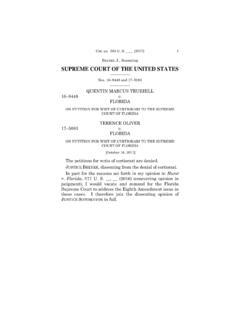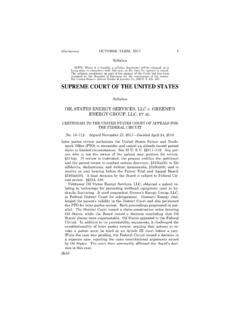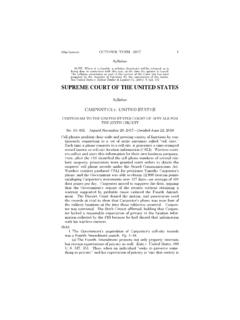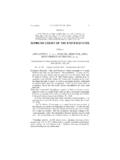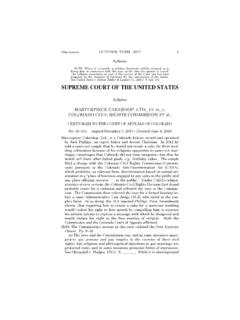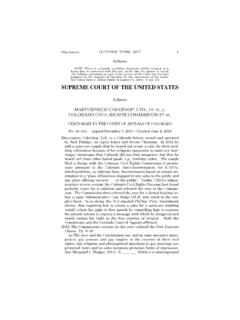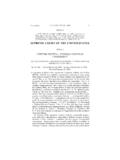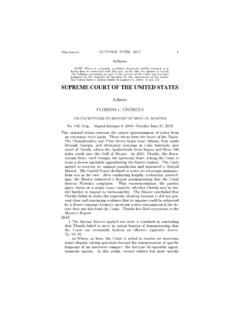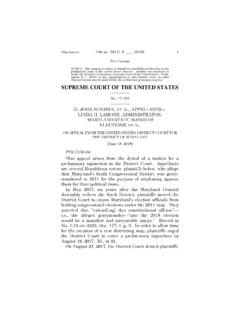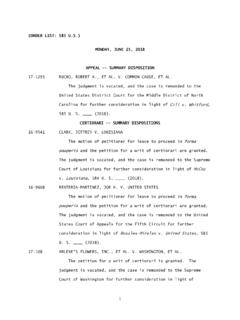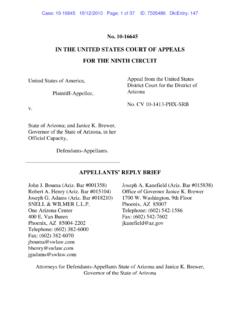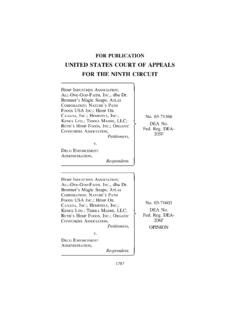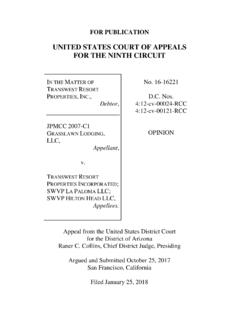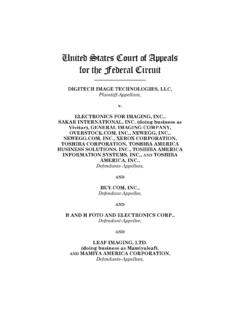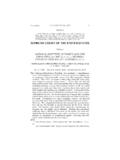Transcription of SUPREME COURT OF THE UNITED STATES
1 1 (Slip Opinion) OCTOBER TERM, 2017 Syllabus NOTE: Where it is feasible, a syllabus (headnote) will be released, as isbeing done in connection with this case, at the time the opinion is syllabus constitutes no part of the opinion of the COURT but has beenprepared by the Reporter of Decisions for the convenience of the reader. See UNITED STATES v. Detroit Timber & Lumber Co., 200 U. S. 321, 337. SUPREME COURT OF THE UNITED STATES Syllabus SESSIONS, ATTORNEY GENERAL v. DIMAYA CERTIORARI TO THE UNITED STATES COURT OF APPEALS FOR THE NINTH CIRCUIT No. 15 1498. Argued January 17, 2017 Reargued October 2, 2017 Decided April 17, 2018 The Immigration and Nationality Act (INA) virtually guarantees that any alien convicted of an aggravated felony after entering the Unit-ed STATES will be deported.
2 See 8 U. S. C. 1227(a)(2)(A)(iii), 1229b(a)(3), (b)(1)(C). An aggravated felony includes a crime of vio-lence (as defined in [18 U. S. C. 16] .. ) for which the term of im-prisonment [is] at least one year. 1101(a)(43)(f). Section 16 s defi-nition of a crime of violence is divided into two clauses often referred to as the elements clause, 16(a), and the residual clause, 16(b). The residual clause, the provision at issue here, defines a crime of violence as any other offense that is a felony and that, byits nature, involves a substantial risk that physical force against the person or property of another may be used in the course of commit-ting the offense. To decide whether a person s conviction falls withinthe scope of that clause, courts apply the categorical approach. This approach has courts ask not whether the particular facts underly-ing a conviction created a substantial risk, Leocal v.
3 Ashcroft, 543 U. S. 1, 7, nor whether the statutory elements of a crime require thecreation of such a risk in each and every case, but whether the ordi-nary case of an offense poses the requisite risk, James v. UNITED STATES , 550 U. S. 192, 208. Respondent James Dimaya is a lawful permanent resident of theUnited STATES with two convictions for first-degree burglary underCalifornia law. After his second offense, the Government sought to deport him as an aggravated felon. An Immigration Judge and the Board of Immigration Appeals held that California first-degree bur-glary is a crime of violence under 16(b). While Dimaya s appealwas pending in the Ninth Circuit, this COURT held that a similar re- 2 SESSIONS v.
4 DIMAYA Syllabus sidual clause in the Armed Career Criminal Act (ACCA) defining violent felony as any felony that otherwise involves conduct thatpresents a serious potential risk of physical injury to another, 18 U. S. C. 924(e)(2)(B) was unconstitutionally void for vagueness under the Fifth Amendment s Due Process Clause. Johnson v. Unit-ed STATES , 576 U. S. ___, ___. Relying on Johnson, the Ninth Circuit held that 16(b), as incorporated into the INA, was also unconstitu-tionally vague. Held: The judgment is affirmed. 803 F. 3d 1110, affirmed. JUSTICE KAGAN delivered the opinion of the COURT with respect toParts I, III, IV B, and V, concluding that 16 s residual clause is un-constitutionally vague. Pp. 6 11, 16 25. (a) A straightforward application of Johnson effectively resolves this case. Section 16(b) has the same two features as ACCA s residu-al clause an ordinary-case requirement and an ill-defined risk threshold combined in the same constitutionally problematic begin, ACCA s residual clause created grave uncertainty about how to estimate the risk posed by a crime because it tie[d] the judi-cial assessment of risk to a speculative hypothesis about the crime s ordinary case, but provided no guidance on how to figure out whatthat ordinary case was.
5 576 U. S., at ___. Compounding that uncer-tainty, ACCA s residual clause layered an imprecise serious poten-tial risk standard on top of the requisite ordinary case inquiry. The combination of indeterminacy about how to measure the riskposed by a crime [and] indeterminacy about how much risk it takes for the crime to qualify as a violent felony, id., at ___, resulted in more unpredictability and arbitrariness than the Due Process Clause tolerates, id., at ___. Section 16(b) suffers from those same two flaws. Like ACCA s residual clause, 16(b) calls for a COURT to identify a crime s ordinary case in order to measure the crime s risk but offers no reliable way to discern what the ordinary version of any offense looks like. Id., at ___. And its substantial risk thresh-old is no more determinate than ACCA s serious potential risk standard.
6 Thus, the same [t]wo features that conspire[d] to make ACCA s residual clause unconstitutionally vague also exist in 16(b),with the same result. Id., at ___. Pp. 6 11. (b) The Government identifies three textual discrepancies between ACCA s residual clause and 16(b) that it claims make 16(b) easierto apply and thus cure the constitutional infirmity. None, however, relates to the pair of features that Johnson found to produce imper-missible vagueness or otherwise makes the statutory inquiry moredeterminate. Pp. 16 24. (1) First, the Government argues that 16(b) s express require- 3 Cite as: 584 U. S. ____ (2018) Syllabus ment (absent from ACCA) that the risk arise from acts taken in thecourse of committing the offense, serves as a temporal restriction in other words, a COURT applying 16(b) may not consider risks aris-ing after the offense s commission is over.
7 Brief for Petitioner 31. But this is not a meaningful limitation: In the ordinary case of any of-fense, the riskiness of a crime arises from events occurring during itscommission, not events occurring later. So with or without the tem-poral language, a COURT applying the ordinary case approach, whetherin 16 s or ACCA s residual clause, would do the same thing askwhat usually happens when a crime is committed. The phrase in the course of makes no difference as to either outcome or clarity andcannot cure the statutory indeterminacy Johnson described. Second, the Government says that the 16(b) inquiry, which focus-es on the risk of physical force, trains solely on the conduct typi-cally involved in a crime. Brief for Petitioner 36. In contrast, ACCA s residual clause asked about the risk of physical injury, requiring a second inquiry into a speculative chain of causation that could possibly result in a victim s injury.
8 Ibid. However, this COURT has made clear that physical force means force capable of causing physical pain or injury. Johnson v. UNITED STATES , 559 U. S. 133, 140. So under 16(b) too, a COURT must not only identify the conducttypically involved in a crime, but also gauge its potential consequenc-es. Thus, the force/injury distinction does not clarify a COURT s analy-sis of whether a crime qualifies as violent. Third, the Government notes that 16(b) avoids the vagueness ofACCA s residual clause because it is not preceded by a confusing list of exemplar crimes. Brief for Petitioner 38. Those enumerated crimes were in fact too varied to assist this COURT in giving ACCA sresidual clause meaning. But to say that they failed to resolve the clause s vagueness is hardly to say they caused the problem. Pp. 16 21. (2) The Government also relies on judicial experience with 16(b), arguing that because it has divided lower courts less oftenand resulted in only one certiorari grant, it must be clearer than its ACCA counterpart.
9 But in fact, a host of issues respecting 16(b) sapplication to specific crimes divide the federal appellate courts. And while this COURT has only heard oral arguments in two 16(b) cases,this COURT vacated the judgments in a number of other 16(b) cases,remanding them for further consideration in light of ACCA 21 24. JUSTICE KAGAN, joined by JUSTICE GINSBURG, JUSTICE BREYER, and JUSTICE SOTOMAYOR, concluded in Parts II and IV A: (a) The Government argues that a more permissive form of the void-for-vagueness doctrine applies than the one Johnson employed 4 SESSIONS v. DIMAYA Syllabus because the removal of an alien is a civil matter rather than a crimi-nal case. This COURT s precedent forecloses that argument.
10 In Jor-dan v. De George, 341 U. S. 223, the COURT considered what vague-ness standard applied in removal cases and concluded that, in viewof the grave nature of deportation, the most exacting vagueness standard must apply. Id., at 231. Nothing in the ensuing years calls that reasoning into question. This COURT has reiterated that deporta-tion is a particularly severe penalty, which may be of greater con-cern to a convicted alien than any potential jail sentence. Jae Lee v. UNITED STATES , 582 U. S. ___, ___. Pp. 4 6.(b) Section 16(b) demands a categorical, ordinary-case reasons expressed in Johnson, that approach cannot be aban-doned in favor of a conduct-based approach, which asks about thespecific way in which a defendant committed a crime. To begin, the Government once again has not asked [the COURT ] to abandon thecategorical approach in residual-clause cases, suggesting the fact-based approach is an untenable interpretation of 16(b).
